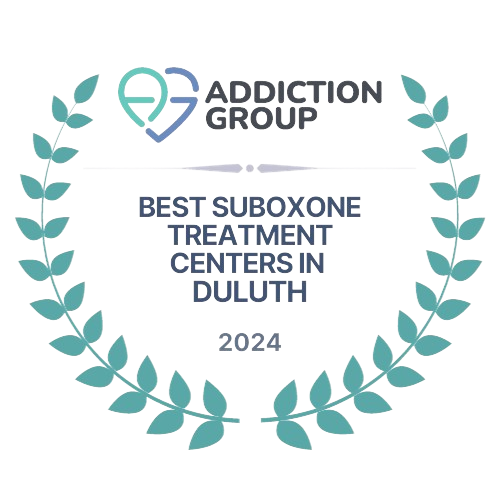Substance Abuse
Award Winning 10-Day Suboxone Detox Program
Medically Reviewed By
Written By
Last medically reviewed February 6, 2025
Substance Abuse
Medically Reviewed By
Written By
Last medically reviewed February 6, 2025
Starting your Suboxone detox journey towards recovery, is a tactical technique to combatting opiate addiction. Whether it comes from heroin or prescription painkillers, this method involves the usage of medication-assisted treatment (MAT) through the combined powers of buprenorphine and naloxone, frequently referred to as Suboxone.
A 10-day Suboxone detox might help handle opioid withdrawal symptoms, but it’s important to talk to a healthcare expert before beginning. Detox needs to be followed by extensive addiction treatment for long-lasting healing and assistance.
This permits individuals to slowly reduce their opioid consumption under the cautious guidance and assistance of doctor. By efficiently managing withdrawal symptoms and cravings, this method helps with a smoother transition into recovery.
Withdrawal symptoms position a significant obstacle for those aiming to overcome opioid dependence. Ranging from mild pain to severe physical and psychological distress, these signs can include queasiness, vomiting, diarrhea, muscle aches, stress and anxiety, insomnia, sweating, and restlessness.
Successfully handling these withdrawal symptoms is vital for attaining successful detoxification and sustaining long-lasting healing objectives. By attending to these difficulties head-on with proper care and attention during the detox process, it assists people stay dedicated to their treatment strategy while decreasing the risk of regression.
Additionally, unmanaged withdrawal symptoms can likewise activate psychological health issues like depression or stress and anxiety disorders if left untreated. For that reason, having medical guidance throughout the detox duration guarantees any complications developing from withdrawal are without delay attended to by healthcare experts well-versed in addiction medicine.
Selecting a recognized detox center that uses extensive healthcare customized specifically to individual needs is crucial for guaranteeing individualized attention throughout the whole procedure.

Beginning your Suboxone detox treatment is a transformative experience tailored to assist individuals break devoid of their opioid addiction. This structured program utilizes medication-assisted treatment, specifically Suboxone, which consists of buprenorphine and naloxone. This effective combination efficiently handles withdrawal signs and cravings while lowering the likelihood of regression.
Throughout this detoxing process, individuals can expect specific turning points and experiences every day. Here’s a breakdown of what you can anticipate at our award winning suboxone detox center:
It’s essential to acknowledge that individual experiences with Suboxone detox might vary depending on aspects like opioid dependence levels and general health status. Nevertheless, adhering to a well-crafted treatment plan under expert guidance during these crucial 10 days enhances the likelihood of a smoother detoxing journey.
Throughout the 10-day Suboxone detox program, it is essential to have continuous medical supervision from healthcare experts specializing in addiction medicine. They will closely monitor your progress, adjust medication dosages if needed, and offer guidance on managing any lingering withdrawal symptoms effectively.
Choosing a reputable detox center or clinic offering comprehensive care and personalized treatment plans ensures optimal support during this pivotal phase of recovery.
Going through withdrawal symptoms during a Suboxone detox can be challenging, but with the right strategies and support, you can successfully manage this phase. Here are some common withdrawal symptoms and effective ways to address them:
It’s crucial to manage withdrawal symptoms under medical supervision. A healthcare professional can offer guidance and prescribe medications like clonidine or non-addictive sleep aids for severe symptom relief.
Remember that everyone’s experience with withdrawal is unique. Communicate openly with your healthcare provider about any discomfort you face during detox; they will tailor a plan specifically for you ensuring safety throughout the journey.

Symptoms of withdrawal during a 10-day Suboxone detox can be challenging, which is why choosing the right detox center is paramount. Your choice of facility can significantly impact your journey towards sobriety and overall success in managing addiction.
Here are key considerations to keep in mind when deciding on a detox center:
Remember seeking professional assistance during your Suboxone withdrawal is vital for safe successful recovery Attempting self-detox without proper medical oversight can lead severe symptoms increase relapse risks by carefully weighing these factors when selecting a suitable detox treatment center, you position yourself smoother transition into sobriety.
Preparing for a Suboxone detox is a crucial step in your journey towards recovery. By taking the time to prepare yourself mentally and physically, you can boost your chances of overcoming withdrawal symptoms and staying committed to your sobriety goals. Here are some key steps to help you get ready for your detox:
Remember everyone’s path towards recovery unique be patient following these steps seeking professional guidance along way setting success embark Suboxone treatment plan.

Hats off to you for successfully completing your 10-day Suboxone detox at our award winning Suboxone detox facility! This is a major milestone, and you should take pride in yourself for taking this crucial step towards healing. However, it’s important to recognize that detox is just the start of your path. Maintaining sobriety demands continuous dedication and assistance. Here are some pointers to help you stay on course:
Say Goodbye to Opioid Withdrawal Symptoms
Suboxone Detox– What to Expect
Starting your Suboxone detox journey towards recovery, is a tactical technique to combatting opiate addiction. Whether it comes from heroin or prescription painkillers, this method involves the usage of medication-assisted treatment (MAT) through the combined powers of buprenorphine and naloxone, frequently referred to as Suboxone.
A 10-day Suboxone detox might help handle opioid withdrawal symptoms, but it’s important to talk to a healthcare expert before beginning. Detox needs to be followed by extensive addiction treatment for long-lasting healing and assistance.
This permits individuals to slowly reduce their opioid consumption under the cautious guidance and assistance of doctor. By efficiently managing withdrawal symptoms and cravings, this method helps with a smoother transition into recovery.
The Significance of Addressing Withdrawal Symptoms
Withdrawal symptoms position a significant obstacle for those aiming to overcome opioid dependence. Ranging from mild pain to severe physical and psychological distress, these signs can include queasiness, vomiting, diarrhea, muscle aches, stress and anxiety, insomnia, sweating, and restlessness.
Successfully handling these withdrawal symptoms is vital for attaining successful detoxification and sustaining long-lasting healing objectives. By attending to these difficulties head-on with proper care and attention during the detox process, it assists people stay dedicated to their treatment strategy while decreasing the risk of regression.
Additionally, unmanaged withdrawal symptoms can likewise activate psychological health issues like depression or stress and anxiety disorders if left untreated. For that reason, having medical guidance throughout the detox duration guarantees any complications developing from withdrawal are without delay attended to by healthcare experts well-versed in addiction medicine.
Selecting a recognized detox center that uses extensive healthcare customized specifically to individual needs is crucial for guaranteeing individualized attention throughout the whole procedure.
The 10-Day Suboxone Detox Process
How to Start Your Suboxone Detox Journey
Beginning your Suboxone detox treatment is a transformative experience tailored to assist individuals break devoid of their opioid addiction. This structured program utilizes medication-assisted treatment, specifically Suboxone, which consists of buprenorphine and naloxone. This effective combination efficiently handles withdrawal signs and cravings while lowering the likelihood of regression.
Throughout this detoxing process, individuals can expect specific turning points and experiences every day. Here’s a breakdown of what you can anticipate at our award winning suboxone detox center:
Your journey begins with a preliminary meeting with doctor who will examine your condition and craft a personalized treatment plan for you. They will determine the suitable dosage of Suboxone based upon elements such as your level of reliance and overall health.
In these early stages, you may encounter moderate withdrawal symptoms as your body changes to being without opioids. These signs might consist of queasiness, muscle pains, anxiety, sleeping disorders, and sweating. However, with correct medical supervision at a trusted detox center or center, these symptoms can be successfully handled.
As you advance through the detox procedure, your withdrawal symptoms ought to gradually lessen. While some pain may continue throughout this duration, it represents progress towards healing and recovery.
By this point in the detox procedure, numerous individuals discover that their withdrawal signs have considerably decreased or disappeared completely. This stage marks a considerable milestone as it suggests successful adjustment to life without opioids.
It’s essential to acknowledge that individual experiences with Suboxone detox might vary depending on aspects like opioid dependence levels and general health status. Nevertheless, adhering to a well-crafted treatment plan under expert guidance during these crucial 10 days enhances the likelihood of a smoother detoxing journey.
Throughout the 10-day Suboxone detox program, it is important to have constant medical guidance from healthcare specialists specializing in addiction medication. They will closely monitor your development, change medication does if required, and offer assistance on handling any remaining withdrawal symptoms successfully.
Choosing a reliable detox center or clinic offering detailed care and tailored treatment plans makes sure optimum assistance during this essential stage of recovery.
Managing Withdrawal Symptoms
How to Cope with Withdrawal Symptoms
Going through withdrawal signs throughout a Suboxone detox can be tough, however with the ideal methods and assistance, you can effectively handle this phase. Here are some typical withdrawal symptoms and reliable ways to address them:
Queasiness and Vomiting: These signs frequently happen at the start of withdrawal. To alleviate queasiness, attempt drinking on ginger tea or electrolyte services. Decide for small, frequent treats rather of heavy meals.
Muscle Aches and Pains: Muscle pain is common during cleansing. Applying heat packs or taking warm baths can offer short-lived relief. Mild extending exercises or light massages might also assist relieve muscle stress.
Sleeping disorders: Sleep disturbances are normal as your body changes to functioning without Suboxone or other opioids. Develop a bedtime regimen that includes relaxation methods like deep breathing exercises or meditation to improve sleep quality.
Stress and anxiety and Restlessness: Changes in brain chemistry due to opioid lack can cause stress and anxiety and uneasyness throughout withdrawal. Participate in soothing activities such as yoga, listening to soothing music, or practicing mindfulness to lower these signs.
Depression and Mood Swings: Mood swings and feelings of anxiety may arise throughout Suboxone detoxification. Stay gotten in touch with supportive friends or family members for emotional assistance during this time.
Tiredness: Fatigue is a common sign throughout the detox procedure as your body adjusts without opioids. Taking short naps rather than extended periods of sleep can combat tiredness while preserving regular daily regimens will assist you stay active regardless of feeling worn out.
It’s crucial to handle withdrawal signs under medical supervision. A healthcare professional can use guidance and recommend medications like clonidine or non-addictive sleep aids for serious symptom relief.
Remember that everyone’s experience with withdrawal is special. Interact freely with your doctor about any pain you deal with during detox; they will tailor a plan specifically for you making sure safety throughout the journey.






